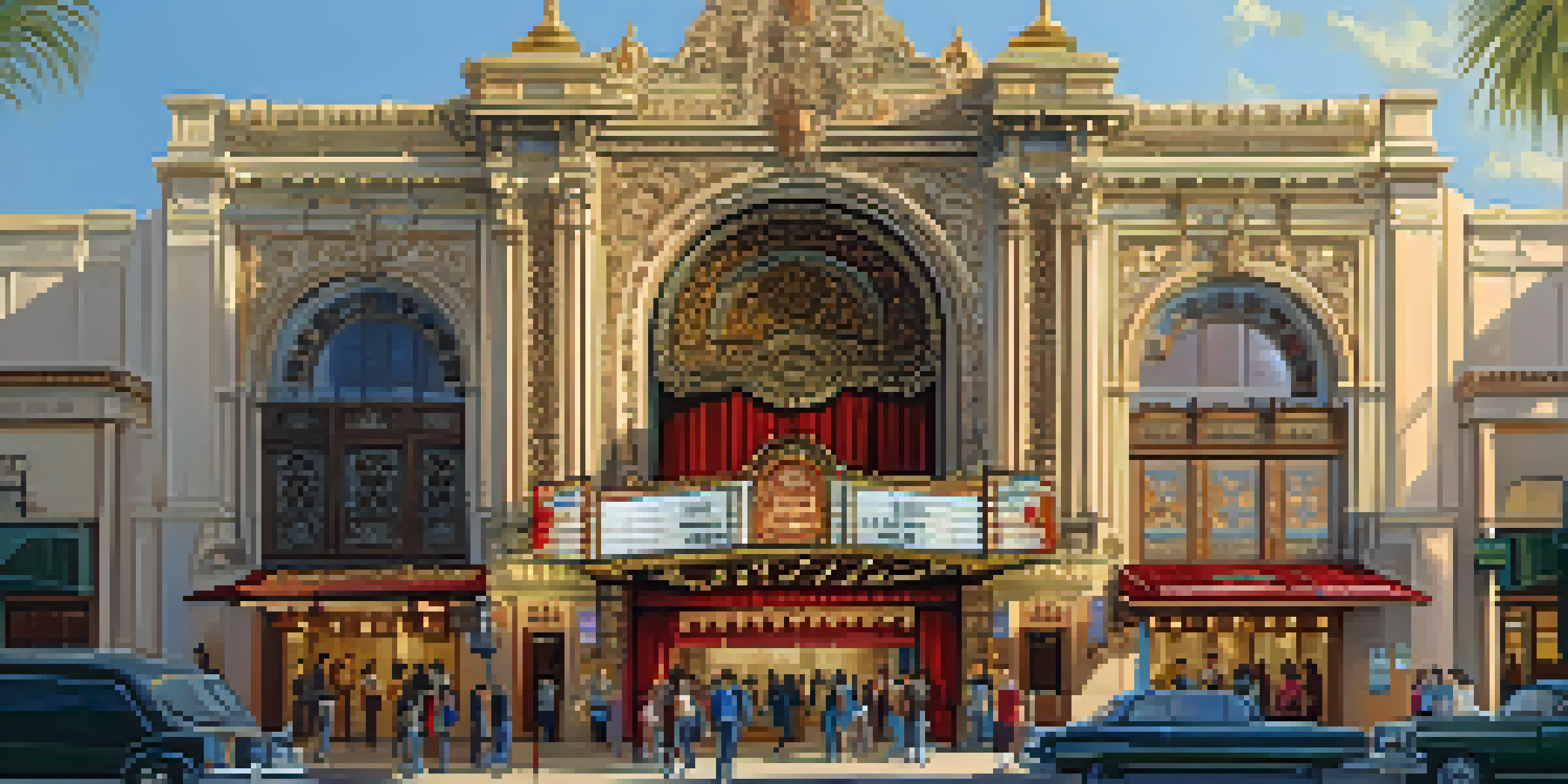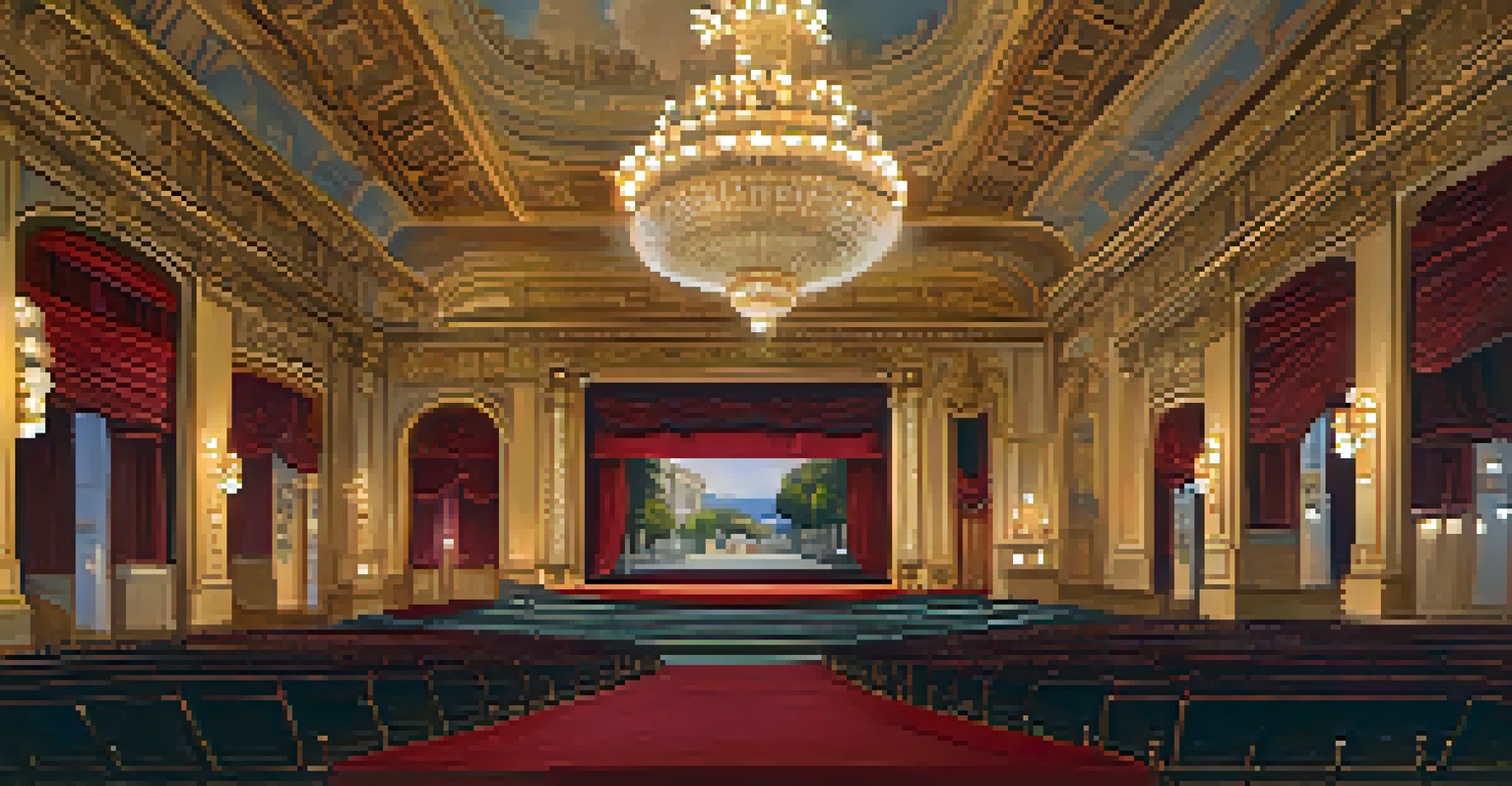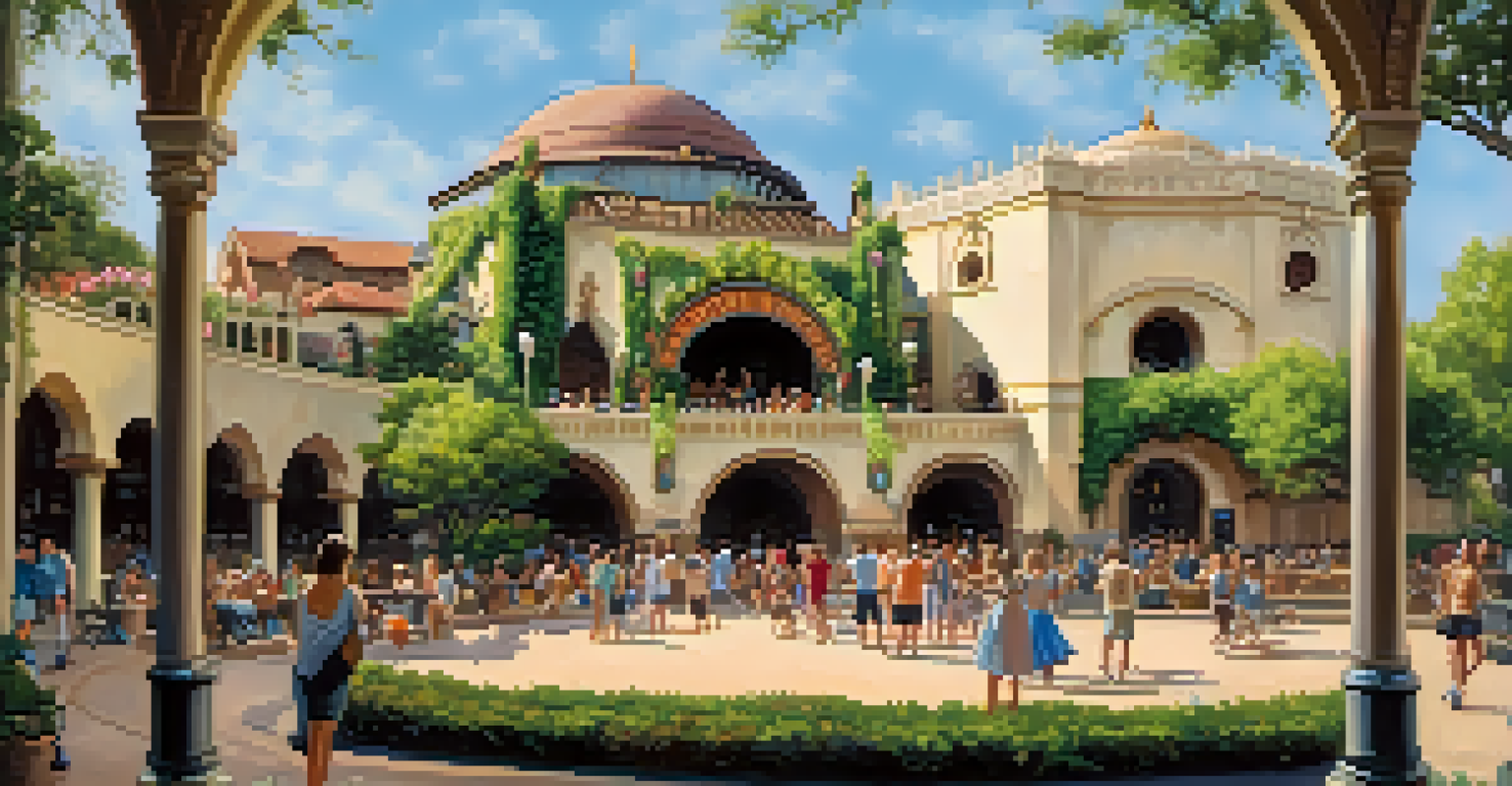Historic Theaters in San Diego: A Journey Through Time

The Birth of San Diego's Theater Scene
San Diego's theater scene began in the late 19th century, reflecting the city's growing cultural landscape. The establishment of venues like the Old Globe Theatre laid the groundwork for a vibrant performing arts community. These early theaters attracted talent and audiences, paving the way for future generations of artists and performers.
Theater is a mirror, a sharp reflection of society and its values, a means of understanding and confronting the world we live in.
In the beginning, many performances were held in makeshift venues or community halls. However, as the city grew, so did the ambition and scale of the productions. The influence of vaudeville and the silent film era brought a new excitement, capturing the imagination of San Diegans and setting the stage for grander theaters.
By the 1920s, the rise of opulent movie palaces marked a golden age for San Diego theaters. These venues combined stunning architecture with the latest technology, providing an immersive experience for audiences. The allure of these historic theaters helped solidify San Diego's reputation as a cultural hub in Southern California.
The Iconic Balboa Theatre
One of the crown jewels of San Diego's theater district is the Balboa Theatre, which opened its doors in 1924. With its stunning Spanish Baroque architecture, the Balboa quickly became a beloved venue for both films and live performances. The theater's ornate interior, featuring intricate plasterwork and a beautiful ceiling, creates a magical atmosphere that enchants visitors to this day.

Originally designed as a movie palace, the Balboa has evolved over the decades to become a prominent venue for live shows. It hosts a variety of performances, including concerts, dance, and theater productions, drawing in diverse audiences from all walks of life. This adaptability has allowed the Balboa to maintain its relevance in a rapidly changing entertainment landscape.
Rich History of San Diego Theaters
San Diego's historic theaters have shaped the city's cultural identity and continue to serve as vital community gathering spaces.
In recent years, the Balboa has undergone significant renovations, restoring its historical charm while upgrading its facilities. These improvements ensure that future generations can continue to enjoy the rich performances that the theater has to offer. As a result, the Balboa Theatre remains a cherished landmark and a testament to San Diego's cultural heritage.
The Majestic Spreckels Theatre
Another iconic venue is the Spreckels Theatre, which opened in 1912 and is known for its exquisite design and ambiance. The theater features a stunning combination of Italian Renaissance and Baroque styles, adorned with lavish decorations that transport visitors back in time. Its grand entrance and elegant lobby create an inviting atmosphere for all who enter.
The stage is not a place for the faint-hearted; it is a place for the bold, the brave, and the beautiful.
Over the years, the Spreckels has hosted a wide range of performances, from Broadway shows to orchestras. The venue's intimate setting allows for a unique connection between performers and the audience, making each event feel special. This sense of community has solidified the Spreckels' place in the hearts of San Diego residents.
Today, the Spreckels Theatre continues to thrive, showcasing a blend of classical and contemporary productions. The venue's commitment to supporting local artists and theater companies ensures that San Diego's rich artistic culture remains vibrant. As a historic landmark, the Spreckels stands as a proud symbol of the city's enduring love for the performing arts.
The Historic Old Globe Theatre
The Old Globe Theatre, nestled in Balboa Park, is perhaps one of the most celebrated theaters in San Diego. Established in 1935, it has gained national acclaim for its innovative productions and commitment to excellence. The Old Globe is especially known for its Shakespeare Festival, attracting theater enthusiasts from across the country.
With three performance spaces, the Old Globe offers a diverse range of programming, from classic plays to contemporary works. This variety allows for creative exploration and experimentation in the performing arts. The theater's dedication to fostering new talent and original stories makes it a vital part of San Diego's cultural fabric.
The Balboa Theatre's Enduring Legacy
The Balboa Theatre, with its stunning architecture and diverse programming, remains a cherished landmark in San Diego's performing arts scene.
In addition to its performances, the Old Globe engages with the community through educational programs and outreach initiatives. These efforts help cultivate a love for theater among younger generations, ensuring the art form's longevity. The Old Globe Theatre remains a beacon of creativity, inspiring audiences and artists alike.
The Enigmatic La Jolla Playhouse
Just north of downtown, the La Jolla Playhouse has made a name for itself as a powerhouse of theatrical innovation. Founded in 1947, this theater has a reputation for premiering new works and developing groundbreaking productions. Its commitment to pushing artistic boundaries has earned it numerous accolades, including Tony Awards.
The Playhouse's intimate setting encourages a close connection between performers and audiences, enhancing the theatrical experience. With a focus on diverse storytelling, the theater showcases a range of voices and perspectives, making it a vital part of the cultural dialogue. This commitment to inclusivity fosters a rich environment for artistic collaboration.
In addition to its mainstage productions, the La Jolla Playhouse offers various programs that support emerging artists and playwrights. This nurturing approach ensures that new talent has the opportunity to shine on stage. As a result, the Playhouse not only entertains but also contributes to the future of theater in San Diego and beyond.
The Regal Fox Theatre
The Fox Theatre, a glamorous venue that opened in 1929, has a storied past that reflects the evolution of San Diego's entertainment landscape. Originally a movie palace, the Fox featured stunning Art Deco architecture, complete with a grand marquee that dazzled passersby. Over the years, it became a hotspot for film premieres and live performances alike.
Despite its closure in the 1970s, the Fox Theatre's legacy lived on, as it became a beloved symbol of the city's cinematic history. Recent restoration efforts have revitalized the theater, preserving its historic charm while modernizing its facilities for contemporary audiences. This blend of old and new makes the Fox a unique destination for theatergoers.
Innovative Spirit of La Jolla Playhouse
La Jolla Playhouse is renowned for premiering new works and nurturing emerging artists, making it a significant player in the theatrical landscape.
Today, the Fox Theatre serves as a venue for a variety of events, from concerts to film screenings. Its rich history and stunning design continue to attract visitors, making it a cherished part of San Diego's cultural landscape. The Fox Theatre stands as a testament to the city's resilience and dedication to preserving its artistic heritage.
Cultural Impact of Historic Theaters
The historic theaters of San Diego have played a crucial role in shaping the city's cultural identity. They serve as gathering places for community members, fostering a sense of belonging and shared experience. These venues have hosted countless performances that reflect the diverse tapestry of San Diego's population.
Beyond entertainment, these theaters have become platforms for social change, addressing important issues through artistic expression. Many local artists have used these stages to share their stories, contributing to the larger conversation about culture and identity. This dynamic interplay between art and society highlights the theaters' significance beyond mere entertainment.

The preservation of these historic venues ensures that future generations can continue to experience the magic of live performances. By maintaining these cultural landmarks, San Diego honors its artistic heritage while embracing the future. The impact of historic theaters in San Diego is profound, weaving a rich narrative that speaks to the city's spirit and resilience.
Visiting San Diego's Historic Theaters
Exploring San Diego's historic theaters is a journey filled with rich history and vibrant performances. Each venue offers a unique experience, from the grandeur of the Balboa Theatre to the intimate setting of the La Jolla Playhouse. Visitors can enjoy guided tours, which often highlight the architectural features and stories behind these beloved landmarks.
Attending a performance at one of these theaters is an unforgettable experience, with diverse programming that appeals to all tastes. Whether you're a fan of classic plays, contemporary works, or live music, there's something for everyone. The atmosphere of these historic venues adds an extra layer of excitement to each show, making it a perfect outing for friends or family.
In addition to performances, many theaters offer educational programs and community events that engage audiences of all ages. These initiatives help foster a lifelong appreciation for the arts and encourage participation in the cultural landscape. Visiting San Diego's historic theaters is not just about entertainment; it's about connecting with the city's rich artistic heritage.